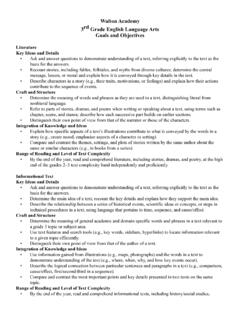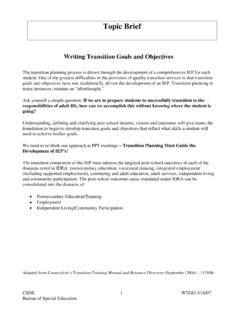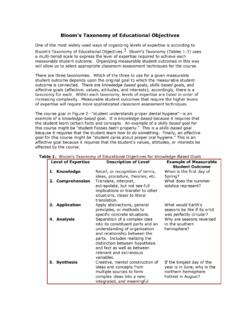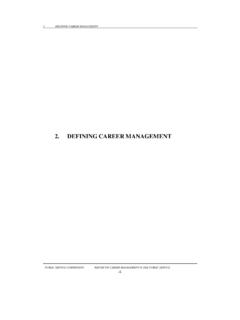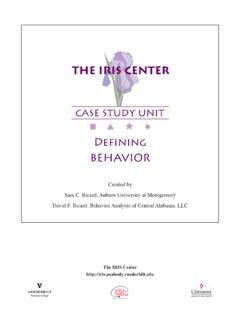Transcription of 3rd Grade Mathematics Goals and Objectives - Walton …
1 Walton Academy rd 3 Grade Mathematics Goals and Objectives Operations and Algebraic Thinking Represent and solve problems involving multiplication and division. products of whole numbers, , interpret 5 7 as the total number of objects in 5 groups of 7. objects each. For example, describe a context in which a total number of objects can be expressed as 5 7. Interpret whole-number quotients of whole numbers, , interpret 56 8 as the number of objects in each share when 56 objects are partitioned equally into 8 shares, or as a number of shares when 56.
2 Objects are partitioned into equal shares of 8 objects each. For example, describe a context in which a number of shares or a number of groups can be expressed as 56 8. Use multiplication and division within 100 to solve word problems in situations involving equal groups, arrays, and measurement quantities, , by using drawings and equations with a symbol for the unknown number to represent the problem. (Note: See Glossary, Table 2.). Determine the unknown whole number in a multiplication or division equation relating three whole numbers.
3 For example, determine the unknown number that makes the equation true in each of the equations 8 ? = 48, 5 = o 3, 6 6 = ?. 2. Understand properties of multiplication and the relationship between multiplication and division. Apply properties of operations as strategies to multiply and divide. (Note: Students need not use formal terms for these properties.) Examples: If 6 4 = 24 is known, then 4 6 = 24 is also known. (Commutative property of multiplication.) 3 5 2 can be found by 3 5 = 15, then 15 2 = 30, or by 5 2 = 10, then 3 10 = 30.
4 (Associative property of multiplication.) Knowing that 8 5 = 40 and 8 2. = 16, one can find 8 7 as 8 (5 + 2) = (8 5) + (8 2) = 40 + 16 = 56. (Distributive property.). Understand division as an unknown-factor problem. For example, find 32 8 by finding the number that makes 32 when multiplied by 8. 3. Multiply and divide within 1000. Fluently multiply and divide within 100, using strategies such as the relationship between multiplication and division ( , knowing that 8 5 = 40, one knows 40 5 = 8) or properties of operations. By the end of Grade 3, know from memory all products of two one-digit numbers.
5 4. Solve problems involving the four operations and identify and explain patterns in arithmetic. Solve two-step word problems using the four operations. Represent these problems using equations with a letter standing for the unknown quantity. Assess the reasonableness of answers using mental computation and estimation strategies including rounding. (Note: This standard is limited to problems posed with whole numbers and having whole-number answers; students should know how to perform operations in the conventional order when there are no parentheses to specify a particular order Order of Operations.)
6 Identify arithmetic patterns (including patterns in the addition table or multiplication table) and explain them using properties of operations. For example, observe that 4 times a number is always even, and explain why 4 times a number can be decomposed into two equal addends. Number and operations in base ten Use place value understanding and properties of operations to perform multi-digit arithmetic. (Note: A range of algorithms may be used.). Use place value understanding to round whole numbers to the nearest 10 or 100. Fluently add and subtract within 10,000 using strategies and algorithms based on place value, properties of operations, and/or the relationship between addition and subtraction.
7 Multiply one-digit whole numbers by multiples of 10 in the range 10-90 ( , 9 80, 5 60) using strategies based on place value and properties of operations. Number and operations Fractions ( Grade 3 expectations in this domain are limited to fractions with denominators 2, 3, 4, 6, and 8). Develop understanding of fractions as numbers. 1. Understand a fraction 1/b as the quantity formed by 1 part when a whole is partitioned into b equal parts;. understand a fraction a/b as the quantity formed by a parts of size 1/b. 2. Understand a fraction as a number on the number line; represent fractions on a number line diagram.
8 Represent a fraction 1/b on a number line diagram by defining the interval from 0 to 1 as the whole and partitioning it into b equal parts. Recognize that each part has size 1/b and that the endpoint of the part based at 0 locates the number 1/b on the number line. Represent a fraction a/b on a number line diagram by marking off a lengths 1/b from 0. Recognize that the resulting interval has size a/b and that its endpoint locates the number a/b on the number line. 3. Explain equivalence of fractions in special cases and compare fractions by reasoning about their size.
9 Understand two fractions as equivalent (equal) if they are the same size, or the same point on a number line. Recognize and generate simple equivalent fractions, , 1/2 = 2/4, 4/6 = 2/3). Explain why the fractions are equivalent, , by using a visual fraction model. Express whole numbers as fractions, and recognize fractions that are equivalent to whole numbers. Examples: Express 3 in the form 3 = 3/1; recognize that 6/1 = 6; locate 4/4 and 1 at the same point of a number line diagram. Compare two fractions with the same numerator or the same denominator by reasoning about their size.
10 Recognize that comparisons are valid only when the two fractions refer to the same whole. Record the results of comparisons with the symbols >, =, or <, and justify the conclusions, , by using a visual fraction model. Measurement and data Solve problems involving measurement and estimation of intervals of time, liquid volumes, and masses of objects. and write time to the nearest minute and measure time intervals in minutes. Solve word problems involving addition and subtraction of time intervals in minutes, , by representing the problem on a number line diagram.
